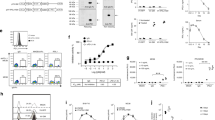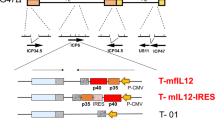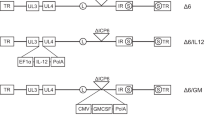Abstract
We previously demonstrated that the switch from non- to highly tumorigenic phenotype of human melanoma cells is directly related to procathepsin L secretion, which increased cell resistance to complement-mediated cell lysis. Involvement of procathepsin L secretion in tumor growth was clearly demonstrated by three different strategies: (1) inhibition of secreted procathepsin L activity; (2) increase of procathepsin L secretion; and (3) inhibition of procathepsin L secretion. This latter strategy was triggered by intracellular expression of anti-human cathepsin L single-chain variable fragment (ScFv). These previous experiments were performed by processing melanoma cells before their injection into nude mice. We herein designed a new lentiviral vector in which this anti-cathepsin L ScFv was cloned. This lentiviral vector was optimized to allow the highest intracellular expression of anti-cathepsin L ScFv in transduced melanoma cells. In these transduced cells, procathepsin L secretion was strongly inhibited. In addition, injection of this anti-cathepsin L ScFv lentiviral vector into tumors already induced in nude mice inhibited tumor growth and associated angiogenesis. This is the first report to demonstrate that targeting procathepsin L secretion with anti-cathepsin L ScFv lentiviral construct constitutes a new gene therapy in the challenge to inhibit the growth of tumors induced by human melanoma cells.
This is a preview of subscription content, access via your institution
Access options
Subscribe to this journal
Receive 12 print issues and online access
$259.00 per year
only $21.58 per issue
Buy this article
- Purchase on Springer Link
- Instant access to full article PDF
Prices may be subject to local taxes which are calculated during checkout








Similar content being viewed by others
Abbreviations
- AcGFP:
-
Aequorea coerulescens green fluorescent protein
- cPPT:
-
central polypurine tract
- anti-CTSL:
-
anti-cathepsin L
- ScFv:
-
single-chain variable fragment
- moAb:
-
monoclonal antibody
- s.c.:
-
subcutaneously
- MOI:
-
multiplicity of infection
- MVD:
-
microvessel density
- sp:
-
signal peptide
- 5′-UTR:
-
5′-untranslated region
- WPRE:
-
woodchuck hepatitis virus post-transcriptional regulatory element
References
Fidler IJ . The organ microenvironment and cancer metastasis. Differentiation 2002; 70: 489–505.
Frade R . Structure and functions of proteases which cleave human C3 and are expressed on normal or tumor human cells: some are involved in tumorigenic and metastatic properties of human melanoma cells. Immunopharmacology 1999; 42: 39–45.
Ollert MW, Frade R, Fiandino A, Petrella EC, Panneerselvam M, Barel M et al. A new complement-regulatory membrane protein : a C3-cleaving proteinase is expressed on complement-resistant human melanoma cells. J Immunol 1990; 14: 3862–3867.
Frade R . Structure and signaling functions of C3 receptors on human B lymphocytes. In: Klaus GB (ed). Transmembrane Signalling in Lymphocytes. Saunders Scientific Publishing Co: Philadelphia, PA, 1990, pp 159–164.
Frade R . Signal transduction through the Epstein–Barr virus receptor in human B lymphocytes. In: d′Alessandro N, Mihich E, Rausa L, Tapiero H, Tritton TR (eds). Cancer Therapy: Differentiation, Immunomodulation and Angiogenesis. Nato ASI Series, Springer-Verlag: Berlin, 1993, pp 33–38.
Lottin-Divoux S, Jean D, Le Romancer M, Frade R . Activation of Epstein–Barr virus/C3d receptor (gp140, CR2, CD21) on human B lymphoma surface triggers Cbl tyrosine phosphorylation, its association with p85 subunit, Crk-L and syk and its dissociation with Vav. Cell Signal 2006; 18: 1219–1225.
Jean D, Hermann J, Rodrigues-Lima F, Barel M, Balbo M, Frade R . Identification on melanoma cells of p39, a cysteine proteinase that cleaves C3, the third component of complement: amino-acid-sequence identities with procathepsin L. Biochem J 1995; 312: 961–969.
Jean D, Bar-Eli M, Huang S, Xie K, Rodrigues-Lima F, Hermann J et al. A cysteine proteinase, which cleaves human C3, the third component of complement, is involved in tumorigenicity and metastasis of human melanoma. Cancer Res 1996; 56: 254–258.
Jean D, Rodrigues-Lima F, Cassinat B, Hermann J, Cabane J, Frade R . Co-expression and secretion of C3, the third component of complement and a C3-cleaving cysteine proteinase in a highly metastatic human melanoma cell line. Immunol Lett 1997; 58: 107–112.
Frade R, Rodrigues-Lima F, Huang S, Xie K, Guillaume N, Bar-Eli M . Procathepsin L, a proteinase that cleaves human C3 (the third component of complement), confers high tumorigenic and metastatic properties to human melanoma cells. Cancer Res 1998; 58: 2733–2736.
Gal S, Gottesman MM . Isolation and sequence of a cDNA for human pro-(cathepsin L). Biochem J 1988; 253: 303–306.
Joseph LJ, Chang LC, Stamenkovich D, Sukhatme VP . Complete nucleotide and deduced amino acid sequences of human and murine preprocathepsin L. An abundant transcript induced by transformation of fibroblasts. J Clin Invest 1988; 81: 1621–1629.
Turk B, Turk D, Turk V . Lysosomal cysteine proteases: more than scavengers. Biochem Biophys Acta 2000; 1477: 98–111.
Chauhan SS, Popescu NC, Ray D, Fleischmann R, Gottesman MM, Troen BR . Cloning, genomic organization, and chromosomal localization of human cathepsin L. J Biol Chem 1993; 268: 1039–1045.
Troen BR, Gal S, Gottesman MM . Sequence and expression of the cDNA for MEP (major excreted protein), a transformation-regulated secreted cathepsin. Biochem J 1987; 246: 731–735.
Amuthan G, Biswas G, Ananadatheerthavarada HK, Vijayasarathy C, Shephard HM, Avadhani NG . Mitochondrial stress-induced calcium signaling, phenotypic changes and invasive behavior in human lung carcinoma A549 cells. Oncogene 2002; 21: 7839–7849.
Gocheva V, Joyce JA . Cysteine cathepsins and the cutting edge of cancer invasion. Cell Cycle 2007; 6: 60–64.
Guillaume-Rousselet N, Jean D, Frade R . Cloning and characterization of anti-cathepsin L single chain variable fragment whose expression inhibits procathepsin L secretion in human melanoma cells. Biochem J 2002; 367: 219–227.
Rousselet N, Mills L, Jean D, Tellez C, Bar-Eli M, Frade R . Inhibition of tumorigenic and metastatic phenotype of human melanoma cells by anti-cathepsin L single chain variable fragment. Cancer Res 2004; 64: 146–151.
Jean D, Rousselet N, Frade R . Expression of cathepsin L gene in human tumour cells is under the control of distinct regulatory mechanisms. Oncogene 2006; 25: 1474–1478.
Jean D, Guillaume N, Frade R . Characterization of human cathepsin L promoter and identification of NF-Y, SP1 and SP3 binding sites that are essential for its activity. Biochem J 2002; 361: 173–184.
Le Hir H, Nott A, Moore MJ . How introns influence and enhance eukaryotic gene expression. Trends Biochem Sci 2003; 28: 215–220.
Shimotohno K, Temin HM . Loss of intervening sequences in genomic mouse alpha-globin DNA inserted in an infectious retrovirus vector. Nature 1982; 299: 265–268.
Noya F, Chien WM, Wu X, Banerjee NS, Kappes JC, Broker TR et al. The promoter of the human proliferating cell nuclear antigen gene is not sufficient for cell cycle-dependent regulation in organotypic cultures of keratinocytes. J Biol Chem 2002; 277: 17271–17280.
Olczak M, Olczak T . Comparison of different signal peptides for protein secretion in nonlytic insect cell system. Anal Biochem 2006; 359: 45–53.
Barry SC, Harder B, Brzezinski M, Flint LY, Seppen J, Osborne WR . Lentivirus vectors encoding both central polypurine tract and posttranscriptional regulatory element provide enhanced transduction and transgene expression. Hum Gene Ther 2001; 12: 1103–1108.
Klein R, Ruttkowski B, Knapp E, Salmons B, Gunzburg WH, Hohenadl C . WPRE-mediated enhancement of gene expression is promoter and cell line specific. Gene 2006; 372: 153–161.
Pellinen R, Hakkarainen T, Wahlfors T, Tulimaki K, Ketola A, Tenhunen A et al. Cancer cells as targets for lentivirus-mediated gene transfer and gene therapy. Int J Oncol 2004; 25: 1753–1762.
Borman AM, Le Mercier P, Girard M, Kean KM . Comparison of picornaviral IRES-driven internal initiation of translation in cultured cells of different origins. Nucleic Acids Res 1997; 25: 925–932.
Harris AL . Hypoxia—a key regulatory factor in tumour growth. Nature Rev Cancer 2002; 2: 38–47.
Kunz M, Ibrahim SM . Molecular responses to hypoxia in tumor cells. Mol Cancer 2003; 2: 23–33.
Glondu M, Coopman P, Laurent-Matha V, Garcia M, Rochefort H, Liaudet-Coopman E . A mutated cathepsin-D devoid of its catalytic activity stimulates the growth of cancer cells. Oncogene 2001; 20: 6920–6929.
Ohri SS, Vashishta A, Proctor M, Fusek M, Vetvicka V . The propeptide of cathepsin D increases proliferation, invasion and metastasis of breast cancer cells. Int J Oncol 2008; 32: 491–498.
Van Hinsbergh VW, Engelse MA, Quax PH . Pericellular proteases in angiogenesis and vasculogenesis. Arterioscler Thromb Vasc Biol 2006; 26: 716–728.
Urbich C, Heeschen C, Aicher A, Sasaki K, Bruhl T, Farhadi MR et al. Cathepsin L is required for endothelial progenitor cell-induced neovascularization. Nat Med 2005; 11: 206–213.
De A, Lewis XZ, Gambhir SS . Noninvasive imaging of lentiviral-mediated reporter gene expression in living mice. Mol Ther 2003; 7: 681–691.
Acknowledgements
We thank Pr Menashe Bar-Eli (MD Anderson Cancer Center, Houston, TX) for helpful discussions. The experiments on mice were performed by Cellvax Inc. (France) with the technical assistance of Dr Delphine Allard and Dr Ming Wei, in the Center for Exploration and Experimental Functional Research (CERFE) of Evry (France). This work was supported by INSERM, the Institut National contre le Cancer (INCa), Association de Recherche contre le Cancer (ARC), Ligue National contre le Cancer (Comité de Paris) and Ministère de l'Education Nationale et de la Recherche Scientifique (MENRS).
Author information
Authors and Affiliations
Corresponding author
Rights and permissions
About this article
Cite this article
Frade, R., Rousselet, N. & Jean, D. Intratumoral gene delivery of anti-cathepsin L single-chain variable fragment by lentiviral vector inhibits tumor progression induced by human melanoma cells. Cancer Gene Ther 15, 591–604 (2008). https://doi.org/10.1038/cgt.2008.51
Received:
Revised:
Accepted:
Published:
Issue Date:
DOI: https://doi.org/10.1038/cgt.2008.51
Keywords
This article is cited by
-
Cathepsin L in tumor angiogenesis and its therapeutic intervention by the small molecule inhibitor KGP94
Clinical & Experimental Metastasis (2016)
-
Cathepsin L in Normal and Pathological Bone Remodeling
Clinical Reviews in Bone and Mineral Metabolism (2011)
-
Proteases in cutaneous malignant melanoma: relevance as biomarker and therapeutic target
Cellular and Molecular Life Sciences (2010)
-
Vector-mediated gene transfer engenders long-lived neutralizing activity and protection against SIV infection in monkeys
Nature Medicine (2009)



